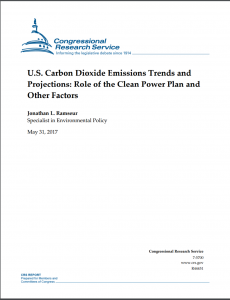Full Title: U.S. Carbon Dioxide Emissions Trends and Projections: Role of the Clean Power Plan and Other Factors
Author(s): Jonathan L. Ramseur
Publisher(s): Congressional Research Service
Publication Date: May 1, 2017
Full Text: Download Resource
Description (excerpt):
Recent international negotiations and domestic policy developments have generated interest in current and projected U.S. greenhouse gas (GHG) emission levels. GHG emissions are generated throughout the United States from millions of discrete sources. Of the GHG source categories, carbon dioxide (CO2) emissions from fossil fuel combustion account for the largest percentage (77%) of total U.S. GHG emissions. The electric power sector contributes the second largest percentage (35%) of CO2 emissions from fossil fuel combustion (one percentage point behind the transportation sector).
In December 2015, delegations from 195 nations, including the United States, adopted an agreement in Paris that creates an international structure for nations to pledge to abate their GHG emissions, adapt to climate change, and cooperate to achieve these ends, including financial and other support. Pursuant to that agreement, the United States pledged (in 2015) to reduce GHG emissions by 26-28% by 2025 compared to 2005 levels. At the date of this report, U.S. involvement in the Paris Agreement remains uncertain. However, some recent reports indicate that President Trump is expected to withdraw from the agreement.
U.S. GHG levels in 2015 were 11% below 2005 levels. Whether the United States achieves its goals would likely depend, to some degree, on CO2 emissions from power plants. In 2015, under President Obama, the Environmental Protection Agency (EPA) promulgated standards for CO2 emissions from existing electric power plants. The rule, known as the Clean Power Plan (CPP), is the subject of ongoing litigation involving a number of entities. On February 9, 2016, the Supreme Court stayed the rule for the duration of the litigation.
Multiple factors generally impact CO2 emission levels from the electric power sector. Some factors are listed below in no particular order:
- Economic growth/recession,
- Relative prices of energy sources for electricity—particularly natural gas and renewable energy sources,
- Electricity generation portfolio (i.e., the ratio of electricity generation from coal, natural gas, and renewable energy sources),
- National and/or state policy developments (e.g., CPP implementation), and
- Demand-side efficiency improvements (e.g., commercial and residential electricity use).
Recent changes in the electric power sector may be informative. Between 1975 and 2010, electricity generation and CO2 emissions from the electric power sector generally increased. However, in 2010, their courses diverged. While electricity generation remained relatively flat after 2010, CO2 emissions from the electric power sector decreased. Thus in 2016, electricity generation was essentially equivalent to generation in 2005, while CO2 emissions were 25% below 2005 levels.
Recent changes in the U.S. electricity generation portfolio played a key role in the CO2 emission decrease. The electricity portfolio affects CO2 emission levels because different sources of electricity generation produce different rates of CO2 emissions per unit of electricity (zero in the case of some renewables). For example, between 2005 and 2016:
- Coal’s contribution to total electricity generation decreased from 50% to 30%;
- Natural gas’s contribution to total electricity generation increased from 19% to 34%; and
- Renewable energy’s contribution to total electricity generation increased from 2% to 8%.
Accurately forecasting future CO2 emission levels is a complex and challenging endeavor. A comparison of actual CO2 emissions (from energy use) between 1990 and 2017 with selected emission projections illustrates this difficulty. In general, actual emissions have remained well below projections.
As the future of the CPP is uncertain, some have questioned whether existing policies and trends in electricity generation would continue to lower CO2 emissions. Modeling results indicate that CO2 emissions in the electricity sector are expected to continue declining. However, modeling results indicate that the declines would be substantially greater if the CPP were implemented.
